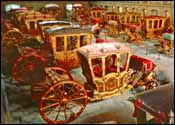

Museu de Arte Popular (Museum of Popular Art)
In a building left over from the 1940 Lisbon World's Fair are displayed the arts and crafts of Portugal, arranged by region. This is the place to acquaint yourself with the range of Portuguese folk artists.Museu Nacional dos Coches (Coach Museum)
Housed in the indoor expanse of the former royal riding school on the grounds of the Palace of Belém (now the home of the president of Portugal), this museum contains an extraordinary collection of coaches.The function of these gilded fantasies was to impress; the least elaborate of them would turn heads if it rolled past today. Of particular note are the of João V, a 17th-century French litter, and the miniature childhood coach of Carlos I. Be sure to glance up at the lovely ceiling frescoes.
Museu da Marinha (Maritime Museum)
This is one of the most important maritime museums in Europe. Three anchors from Columbus's Niña stand by the entrance. On display inside are models and actual craft from the era of the great Portuguese discoveries. Most are caravels, the ship that Columbus chose for his voyage to the New World. Without the innovation of the caravel's free ateen rigging, which allowed sailing closer to the wind than stationary square sails, Africa could not have been rounded. Some of the uniforms on display are splendid in a Gilbert-and-Sullivan way.The entrance to this museum is at the west end of the Mosteiro dos Jerónimos (Jerónimos Monastery).
Museu Nacional de Arte Antiga (National Museum of Ancient Art)
This certainly is the finest museum extant of Portuguese painting. It is housed half in the Count of Alvor's 17th-century palace (Pombal lived herefor a while) and half in a modern addition, where the west end provides the
entrance. Get a floor plan at the desk. Inside and downstairs is the chapel of Santo Alberto, preserved from a former convent on this site; its wooden sculpture is noteworthy, as are the azulejos. The second floor is devoted to Portuguese painting, including the one acknowledged masterpiece of the nation: the 15th-century polyptych of six wooden panels by Nuno Gonçalves The Adoration of Saint Vincent. Other works include those by the 16th-century painter Frei Carlos, the 19th-century Domingos de Sequeira, Bosch (The Temptations of St. Anthony), Dürer, Velazquez, Ribera, and Holbein the Elder. There's also a superb collection of French silver tableware and furniture, as well as Portuguese and Portuguese influenced tapestries, carpets, and furniture.


